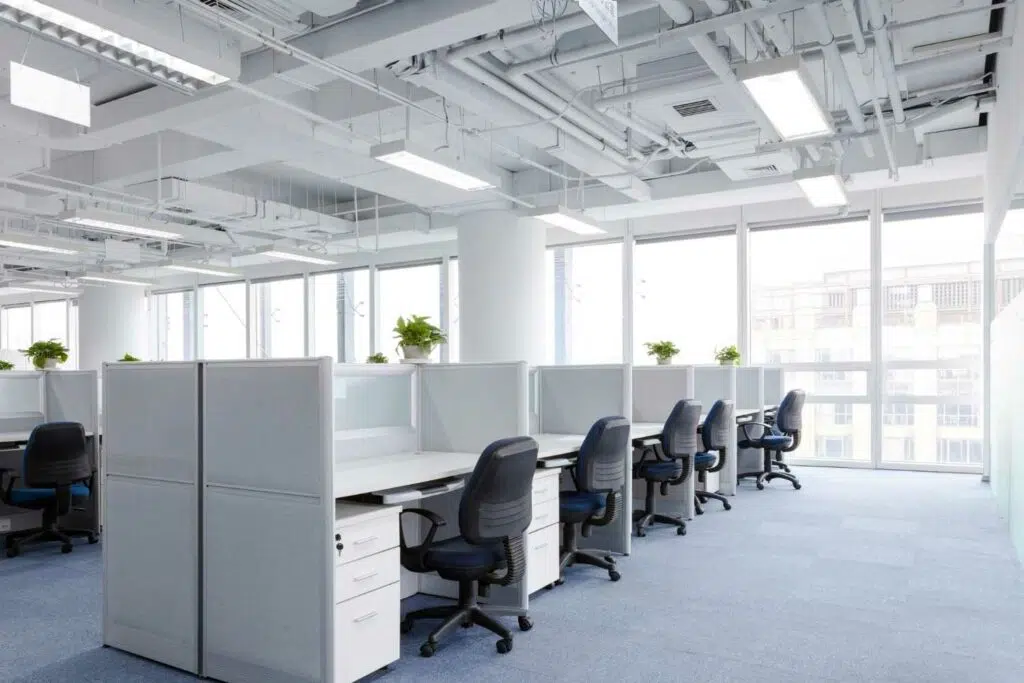
Revolutionising Energy Management in UK Businesses
In an era where sustainability is not just a buzzword but a business imperative, UK companies are increasingly turning to innovative solutions to manage their
A modern workplace has to be able to provide and adapt to many different activities and scenarios. For most, a workplace that promotes productivity, inclusivity, and a culture is the true goal.

To have a healthy, green, sustainable working environment, one that you and your team can be proud of must be a target for any business. Even as huge changes have happened to how we perceive the workplace over the last couple of years, if you look at organisations at the very forefront of technology, innovative companies like Google and Apple, they are still trying to create the best working experience possible. This is true, even if people are not in the office as much as they were previously.
The work-spaces that these organisations are creating have fantastic working environments both from a health perspective and also from a green, sustainable aspect. These workplaces have been purpose-built for this goal. That does not mean you cannot improve and adapt upon a current workspace to equally provide for all.
Up until recently, people spent more hours at work than they did at home or elsewhere. For many organisations, finding the happy medium between home and office working involves creating a greener, healthier office environment. Companies have crucial roles to play in this regard. Roles that as things go forward, employees will come to expect.
A sustainable and healthy workplace produces happier and more motivated workers. This eventually increases employee productivity and fewer work-related hazards, illnesses, and mishaps. Fundamentally, this will improve the overall revenue and reputation of the organisation, and can also be combined with a positive return on investment.
The most critical aspect of work-life that influences employee motivation and productivity is the working environment. There are some studies to suggest that it is even more important than a job description or salary. People tend to closely link the working environment to the culture of the company. Therefore, if you want people to buy into your culture, your organisation must create the perfect space for them.
Clearly there are significant benefits to creating a healthier, greener office. The next question is, how is this achievable without a significant impact on your team?

We first need to understand how a healthier and greener office can sometimes be a contradiction in terms. To create the healthiest environment possible, there has been a motivation to bring in more fresh air from the outside.
The use of mechanical interventions within the workspace to ensure the space is healthy, has been poorly utilised. This is where the conflict between a healthy and a green space occurs. There is a huge energy requirement in bringing in fresh air to then heat or cool it to office temperature. This extra energy usage is similarly mirrored in the running mechanical interventions all the time to potentially manage a problem that is not there.
The implications of bringing this fresher air to a ventilation system can be as much as doubling energy usage. Doing this can lead to an enormous impact on both cost and carbon emissions.
Likewise, if you purely focus on making a workspace as green as can be, there is likely to be re-circulation of air, and use of spaces that is not conducive to having the healthiest working environment, thereby impacting the overall health of the workforce.
This demonstrates the challenging tightrope that creating a green and healthy environment brings with it. Neither decision nor goal can be achieved in isolation without understanding the complex interaction between the two.
The first major step is to understand as much about the working environment as possible. To improve, first, we need to understand. Throwing technology at a problem when it is not fully understood is a sure-fire way to waste a lot of money and not achieve the initial objectives.
This has been felt by many organisations who have put into place isolated solutions such as a solo CO2 monitor, which will have little to no impact on the overall health of the workspace.
To ensure the solution achieves the initial goal, the monitoring of several different internal factors needs to occur. These factors include air quality, humidity, temperature, occupancy, and energy usage to name but a few.
The reason for this is that before making any large-scale changes to the internal environment, it is imperative to understand what “normal” looks like over a period of time, and also to see how this fluctuates under different usage time-frames and scenarios.
Once a baseline has been collated, it is possible to start looking at how improvements can be made and the impact that they have on the previous environment within the workplace. This enables the capture of not only physical changes to the fabric of the workplace, but also to understand how behaviours change over time. Only then can the impact these have on the health and sustainability of the office be clearly defined. These human behaviours can have almost as much impact as technological ones. Think of leaving all the lights on or leaving all the windows open in cold weather.
This kind of principle of intelligent decision-making in itself is not new. Similar data utilisation, to inform decision-making, has been used in many industries to enable enhanced maintenance techniques based on risk and condition, rather than just time intervals.
In the railway industry, for instance, knowing the condition of a specific component has enabled advances in ways railway companies can manage and maintain their trains, creating massive financial and environmental benefits. In this scenario, a positive outcome of improving performance and reducing maintenance periodicity has combined providing real-world benefits.
By changing what we monitor in the working environment, the focus has moved to use the data to help an organisation create a greener, healthier space. Rather than trying to push or increase the life of an asset, we are trying to understand the impact that these initiatives have on making the office greener and healthier, and the potential they have upon the occupants within and at the same time the impact on energy usage.

The best initiatives are those that can integrate fully within your current working processes, but still have the ability to provide benefits within these key areas. It is critical not to create a siloed system with no outputs beyond a dashboard. Otherwise, you can create a situation where a team member must watch a computer screen all day. These tend to have very short-term benefits before eventually being ignored.
There are several ways to monitor all the major data parameters within the office environment. One of the best solutions is to collate all the data in a singular usable depository, which enables multiple use cases for the same initial collection.
The information collated from this data requires a new breed of wellness technology (Welltech) that can enable real insight to be provided from this variety of data streams.
This insight also needs to be fed into the workflow so that actions can be taken to ensure the overall workplace environment is improving. It is once again key to ensure that there is an actionable workflow at the end of any system. Otherwise, we are monitoring for the sake of it, and there will unlikely be any real improvements to the health or sustainability of the space.
By bringing together this long-standing principle of using data to create understanding and then using that understanding to create insight and actions, it is possible to create and manage a working environment that does not require a change in the way your team goes about their daily work in the office.
So, to go back to the initial question, can a workplace be transformed into a healthier, greener environment, the answer is a resounding… Yes!
There are many hurdles to overcome in achieving this. It is essential to not try to find solutions before understanding what the current problems are, and then use this to determine the best path forward to achieving this ultimate goal.
There will always need to be some trade-off between the two factions, but it is possible to make significant improvements to both of these areas without having a impact on the other. It has also been seen that if this activity is carried out in the right way the investment will have a positive return. Minimising sickness rates and increasing productivity, to name but a few, will have a positive influence on any business.
For the workplace to be seen as the cultural and focal point of your business once again, you must look at how you can make it a greener, healthier environment.
Why not book a consultation with a expert from Envelo to see how we could assist in making your workplace a better environment for your employees and customers.

In an era where sustainability is not just a buzzword but a business imperative, UK companies are increasingly turning to innovative solutions to manage their

In the dynamic world of work, it is crucial to adapt to emerging trends that shape the future of our workplaces. As we approach 2023,

Embracing Innovation with Envelo for Sustainable Business Operations In today’s business landscape, there has been a remarkable shift in the way organisations approach energy consumption.
Complete our survey below to see how your business performs.
Wanting to improve your workplace health and well-being, whilst reducing workplace sickness and improving productivity? Book a demonstration with one of our team today, and see how Envelo can monitor, manage and improve your workplace environment.
Envelo protects people from viruses and pollution and helps improve their wellbeing using prevention methods and app-driven monitoring technology.

Envelo Solutions Ltd (Company Number: 13100630)
Complete the form below to see Envelo’s smart technology platform in action. We’ll get back to you within 24 hours to schedule the best date and time to suit you.